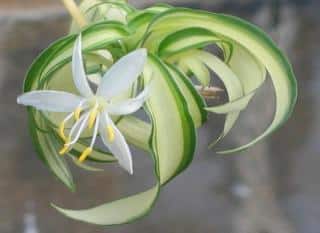

Chlorophytum is native to South Africa and is found appealing for the beauty of its foliage.
Key Chlorophytum facts
Name – Chlorophytum
Family – Liliaceae (lily family)
Type – indoor plant
Height – 10 to 12 inches (25 to 30 cm)
Exposure – Very well-lit
Soil – soil mix
Foliage – evergreen
Care, repotting, watering and exposure, are items to focus your attention to make your chlorophytum even nicer.
Upon purchasing, if the pot is too small, feel free to repot your chlorophytum so that it may have space and grow well.
After that, every 2 or 3 years and preferably in spring, repot your chlorophytum in a pot of a very slightly larger size.
Eliminate dead and wilted leaves as you notice them, only snipping off the portion that has already died off and leaving the healthy part intact.
The best place to set up your chlorophytum is near a window that lets a lot of light through, but isn’t in direct sunlight.
The elevated needs in terms of moisture make this plant likely to thrive in a well-lit bathroom.
The more light a chlorophytum receives, the nicer its foliage.
Absolutely avoid setting it near heat sources such as radiators, because moisture is what this tropical plant needs most.

All year long and especially during summer, spray water on the leaves to recreate the moisture levels of its natural habitat.
Keep the soil mix moist and check that water drains properly.
Add green plant liquid fertilizer every 8 to 15 days during the growing phase.
Reduce watering and wait for the soil to be dry before watering again. The cooler the surrounding temperature gets, the less you need to water.
Most diseases targeting the plant are common indoor plant diseases, red spider mites and scale insects.
If the leaves start losing their shine, it is a good idea to give it more light.
Tips of leaves drying and yellowing are often a sign of lacking fertilizer and/or moisture. So mist the leafage with soft water and add fertilizer regularly.
A fabulous indoor plant, Chlorophytum often comes in one of two varieties: C. elatum and C. comosum. Both adapt well to indoor house temperatures all year round, and can even cope with cooler air in winter, from 50 to 60°F (10 to 15°C).
This plant often sends out runners. Simply let the tip rest in a small pot with fresh soil. When roots have formed, you can cut it away from the mother plant!
Read also: